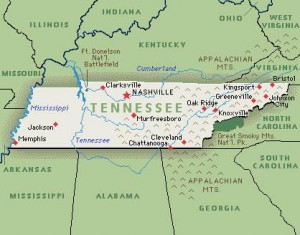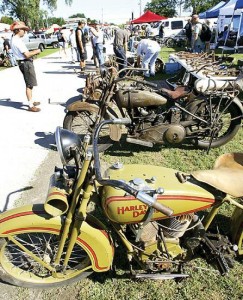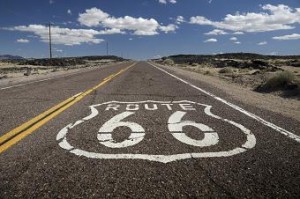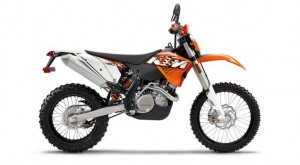Visiting motorcycle museums is a fascinating walk through the timeline of motorcycle history, with an incredible array of bikes, memorabilia, and publications on display. Many motorcycle museums are directed by nonprofit foundations and hold special motorcycle raffles at least once a year. Following are four museums you don’t want to miss.
 Image to the left taken from the Motorcycle Hall of Fame website.
Image to the left taken from the Motorcycle Hall of Fame website.
Motorcycle Hall of Fame Museum:
The Motorcycle Hall of Fame Museum opened in 1990 in Westerville, Ohio. In 1999, it moved to Pickerington, Ohio, the home of the American Motorcycle Heritage Foundation. Not only does the AMHF run the museum, but it also preserves motorcycling’s history, participates in research, and creates educational programs.
The museum features exhibits on dirt racing, Ohio-made Hondas, and classic bikes. The Hall of Fame exhibit celebrates prominent figures in motorcycling, and the Founders Hall recognizes those who contributed to the museum. The museum is open 9 a.m. to 5 p.m. seven days a week, and is closed New Year’s Day, Easter, Thanksgiving Day, and Christmas Day.
Founded in 1989, the National Motorcycle Museum is located in Anamosa, Iowa, and is open seven days a week. During the summer, its hours are Monday through Sunday 9 a.m. to 5 p.m., and during the winter, it is open Monday through Saturday from 9 a.m. to 5 p.m. and Sunday from 10 a.m. to 4 p.m.
The museum is operated by a nonprofit entity and has over 300 motorcycles on display. Exhibits include the lives of Arlen Ness and Evel Knievel, motorcycle movies such as “Easy Rider,” and antique motorcycles and other vehicles. A visit to the website’s tour page gives you just a glimpse of the incredible displays.
 Image to the left taken from the Wheels Through Time Museum website.
Image to the left taken from the Wheels Through Time Museum website.
Located in Maggie Valley, North Carolina, the Wheels Through Time museum displays over 300 American vintage motorcycles from manufacturers such as Harley-Davidson, Indian, Henderson, and Excelsior. Other exhibits include a chopper graveyard, board track racing, and police motorcycles. The museum houses tens of thousands of motorcycle photos, parts, artwork, and artifacts.
Founded in 1993, the museum is open Thursday through Monday from April through October, and its gift shop sells clothing, posters, DVDs, and other memorabilia. The website offers videos, virtual tours, and glimpses behind the scenes.
Barber Vintage Motorsports Museum:
In 1989, George Barber wanted to preserve global motorcycle history and began collecting motorcycles and other vintage vehicles from around the world. In 1995, his collection opened to the public in Birmingham, Alabama, and today the museum has over 1200 motorcycles as well as rare and unusual cars, including the largest collection of Lotus racecars in the world.
The Barber museum is open year-round, closed only on major U.S. holidays. It holds special events such as the Barber Vintage Festival, a celebration of all things motorcycle, including a parts swap meet and motorcycle auction. The Barber Motorsports Park in Birmingham holds shows and events from spring through fall, and the Barber Vintage Museum Library holds over 6,000 books and motorcycle magazines.
Have you been to one of these museums, and what was your favorite exhibit or memorabilia? As South Carolina motorcycle accident attorneys, we always find the innovations in safety particularly fascinating.
Choosing which handlebars you install on your bike can be challenging but fun. Handlebars affect your comfort and the look and handling of your bike, and understanding each type of handlebar will help you make an informed decision you’ll be happy with.
 Image to the left of Ape Hangers taken from Hill Country Customs.
Image to the left of Ape Hangers taken from Hill Country Customs.
Ape Hangers are used on choppers, and they stand tall over the bike. Your arms reach up to grab them, and then rest wide and above your chest or head, which is why they’re called ape hangers. Ape hangers up to 20 inches are available, but some states have height restrictions. South Carolina does not regulate handlebar height.
Clip-ons are two short handles that attach to the fork tube with a clip, unlike one-piece handlebars that attach with a bar to the triple tree. They are adjustable and popular on sport bikes.
Clubman handlebars slant down and toward you, keeping your hands and arms close to your body. Riders choose these handlebars when they’re looking for an old-school look.
Image to the right of Drag Bars taken from Hills Country Customs.
Drag bars connect to the triple tree and are straight across or have a slight backward slope toward the rider for a forward, aerodynamic riding position.
Standard cruisers slant toward the rider, and are the stock handlebars on many Japanese and Harley-Davidson bikes. Designed for comfort, these long handlebars allow you to sit upright and are height adjustable.
Z-bars angle sharply and appear to be backward Zs meeting. The rise varies in height, and some Z-bars are also ape hangers.
If you’re not sure which type suits you, try sitting on your bike in the most comfortable position for your back. Position your arms in their most comfortable position, and have someone measure the height and width of your hands relative to the bike. Then take the measurements into a bike dealer and test handlebars until you find the ones you like.
Whether you have the handlebars installed or do them yourself, double check the installation to make sure it’s secure. It’s also a good idea to keep an eye on handlebar and motorcycle manufacturer recalls. One of the biggest issues Ladson and Ravenel motorcycle accident attorneys deal with is incorrectly installed handlebars.
If you’ve customized your handlebars, which did you choose and why?
Image to the left taken from qctimes.com.
Motorcycles have come a long way since the steam-powered bicycle, or steam velocipede, was patented in the US in 1866. It looked just like a bicycle with an engine, and motorcycles had this basic design for years. By 1868, the velocipede had two cylinders and its own coal-fired boiler. Later, three-wheeled “Moto-Cycles” and steam-powered tricycles made an appearance, and handlebar controls came into use.
The United States was not the only country racing to create motorcycles. In 1885, Gottlieb Daimler and Wilhelm Maybach invented a single-cylinder, gasoline-powered two-wheeled vehicle called the Daimler or the Reitwagen, which is commonly recognized as the first true motorcycle. Daimler’s bike had a wooden chassis and wheels with iron rims and wooden spokes. Several years later, Alex Millet’s motorcycle had pneumatic tires and a five-cylinder engine.
Before 1900, scores of motorcycle designs emerged from Europe and the United States, and most utilized the internal combustion engine. Few were available to the public for purchase at this time. As you might expect, these motorcycles had low compression and not much power, but they were exciting.
One of the earliest motorcycles from bicycle maker Royal Enfield had a 239 cc front-mounted engine that drove power through a belt to the rear wheel. While some early motorcycles were two-stroke, the four-stroke engine known as the Otto Cycle became popular. In 1898, Triumph, also an English bicycle manufacturer, began building motorcycles and the Metz Company of Massachusetts began building the Orient-Aster. A few years later, Harley-Davidson and Indian entered the U.S. market. Indian’s first model was diamond framed with an American-made engine and was painted its trademark red color.
As interest in motorcycle sports grew during this time, so did innovation, and the design of the bike started evolving away from its motorized-bicycle look. By the time World War I started, motorcycle companies were producing thousands of bikes a year, and many were put to good use during the war. After the war ended, BMW came on the scene with motorcycles that were equipped with a shaft drive and a horizontally opposed boxer engine housed with the transmission.
Image to the right taken from motorcycleclassics.com.
Even though the Depression impacted motorcycle companies, Ariel introduced a 1000 cc bike, and Matchless made great technological strides with their V-4 593cc Silver Hawk. In 1934, the OHV Meteor engine was introduced, which was capable of 90 mph. Two years later, the V-twin 998 cc engine achieved speeds of over 100 mph. A new land speed record of 136 mph was set on a modified 1000 cc OHV Harley.
In the 1940s, Honda was founded, and Harley-Davidson replaced their knucklehead engine with the panhead engine and introduced the Hydra-Glide and its new front end. Vincent’s Black Shadow and Black Lightning reached speeds of over 125 mph. During the 1950s, Harley’s FL received a new frame and swinging arm plus a new name—Duo-Glide. Kawasaki, Suzuki, and Yamaha entered the market, and the British manufacturers declined.
The 250 cc motorcycle came of age in the ‘60s with Ducati’s Mach 1, the fastest in its class. Suzuki contributed a two-stroke twin T series engine, and after 1966, their engines were auto oil injection. Harley’s Duo-Glide received an electric start and changed its name to Electra-Glide. Norton’s bikes used a new rubber mounting system to reduce vibration, and Kawasaki introduced a three-cylinder, two-stroke machine. Yamaha’s latest bike had an SOHC parallel twin cylinder engine.
During the 1970s, manufacturers upgraded their engines, and Suzuki introduced several three-cylinder models, while Kawasaki added a four-cylinder SOHC engine. Other innovations included desmodramic valves, autolube systems, full fairing, and left-side gear change. In the ‘80s, Harley-Davidson introduced the Softail model, some bikes receive wind protection, and a major technological leap was antilock brakes on the BMW K1 bikes.
The end of the 20th Century and the beginning of the 21st Century saw a rotary engine bike, the Harley Evolution engine, and the first production diesel-powered motorcycle. Motorcycles continue to evolve technologically and aesthetically. As Goose Creek vehicle accident attorneys, we’re fascinated by changes in motorcycle technology.
If you had to choose the most significant advance in bikes, what would it be, and why?
 If you’re a history buff, a little searching will find motorcycle tours to just about anywhere you’re interested in visiting. Below are historical trips ranging from one day to two weeks and from one state to several. If you know of any motorcycle tours that other history lovers would enjoy, please let us know!
If you’re a history buff, a little searching will find motorcycle tours to just about anywhere you’re interested in visiting. Below are historical trips ranging from one day to two weeks and from one state to several. If you know of any motorcycle tours that other history lovers would enjoy, please let us know!
Trail of Tears Motorcycle Ride
This three-day ride commemorates the Trail of Tears, the brutal journey that tens of thousands of Indians took when soldiers forcibly removed them from their homes and sent them to Oklahoma to live during the 1800s. The ride begins on the third Saturday of September each year in Chattanooga, Tennessee, and continues to Tahlequah, Oklahoma, ending at the Cherokee Heritage Center. For more information, visit http://www.trailoftears-remembrance.org.
Historic Adventure Rides in Tennessee 
East Tennessee offers a multitude of short motorcycle rides, including the Eighth Wonder of the World Ride, which ends at the 400-foot-tall Natural Tunnel in Duffield, VA. The East Tennessee Snake ride cruises through Revolutionary War towns such as Shady Valley, Elizabethton, and Stoney Creek. If you’re interested in local history, the Places of the Past Ride takes you through Tennessee’s oldest town, Jonesborough, where you’ll see historic buildings and landmarks. Other East Tennessee rides are outlined here: http://www.johnsoncitytnchamber.com/mediaguide/pdf/oa_3-Motorcycles.pdf
Frontier Forts and Trading Post Loop Ride
This single-day trip in Montana starts at Culbertson and goes through the Fort Union Trading Post; Fort Buford, where Sitting Bull surrendered; the Lewis and Clark Interpretive Center; and the Fairview Lift Bridge. For those who love old west towns, try the Just Ride tour, which takes you to the frontier town of Scobey, just a few miles south of the Canadian border. Several more Montana motorcycle tours are outlined at http://visitmt.com/experiences/scenic_adventures/motorcycle_touring/high_plains/.
On this 14-day tour, the road you’ll take is historic. Route 66, also known as “The Mother Road,” runs from Chicago to Los Angeles, and this tour takes you through the heart of America. You’ll see history meld with the present and visit cities such as St. Louis, Tulsa, Amarillo, and Laughlin. You’ll see the Grand Canyon, the Chain of Rocks Bridge, Ice Cave, Meramec Caverns, the Cadillac Ranch, and the Route 66 Museum. Tour information can be found at http://www.ridingroute66.us/index.asp.
What’s your favorite motorcycle tour?
Lane splitting is riding your bike between lanes, including maneuvering between lanes of slow or stopped traffic. It’s also called filtering, stripe riding, and white lining.
Laws vary, but generally, lane splitting is not allowed in most areas of the U.S., with the exception of California. Some states do not specifically ban lane splitting, but have other laws in place that effectively condone or forbid it. South Carolina specifically prohibits lane splitting. Motorcycles are entitled to a full lane just as cars are, and motorcycles can travel two abreast in a single lane. Check with law enforcement in your state.
Some of the dangers of lane splitting include . . .
- Car doors opening suddenly, causing loss of control.
- Cars changing lanes without warning or signals.
- Hands, dogs, or objects coming out of windows.
- Drivers of larger vehicles not seeing you.
- Drivers not seeing you at intersections and turning.
If you split lanes, most of these dangers can be avoided by being aware of cars around you, adjusting your speed to conditions, staying out of drivers’ blind spots, wearing bright clothing, and making noise when you’re moving. When you stop, stay in front or behind a car, and always make sure drivers can easily see you. At intersections, always assume a car will turn and stay away from the side. Remember, cars cannot see you as easily as you can see them.
While drivers and law enforcement consider lane splitting dangerous (we do too), proponents of lane splitting say that it reduces rear-end collisions for bikes and reduces traffic congestion. Opponents say it is dangerous and doesn’t offer any real congestion relief because of the low numbers of motorcycles. Unfortunately, in case of accident, riders are often deemed at fault if the crash occurs while lane splitting, even in areas where it’s legal.
Do you split lanes, and why or why not?
 Summertime typically evokes happy memories of cookouts, boating, family vacations and fun in the sun. While sunburns, jelly fish stings and broken air conditioning units represent some of the not-so-fun summer experiences, DUI arrests fall into their own category of a summer nightmare.
Summertime typically evokes happy memories of cookouts, boating, family vacations and fun in the sun. While sunburns, jelly fish stings and broken air conditioning units represent some of the not-so-fun summer experiences, DUI arrests fall into their own category of a summer nightmare.
In a recent decision by the South Carolina Court of Appeals, State v. Herchek, the issue before the Court was whether police are required to videotape a suspected DUI defendant’s conduct for the required 20-minute pre-breath test period if the defendant refuses to take the breath test. While the opinion rendered in this case is unpublished, and therefore can not be cited or used to set precedent, it nevertheless provides important guidance on this issue.
Mr. Herchek was detained under suspicion of driving under the influence and refused to submit to a breath test. While it is required by South Carolina Statute § 56-5-2953, to record a Defendant’s conduct at the breath test site for a 20-minute observation period, the officer failed to do so, as it was not required under South Carolina Law Enforcement Division (SLED) policy. The Magistrate in Herchek’s case, therefore, dismissed the DUI charge on this ground.
The State appealed to the Circuit Court, which upheld the Magistrate’s dismissal. The State then appealed the Circuit Court’s ruling to the Court of Appeals, where the dismissal was again affirmed.
It is worth noting that as of May 2011, SLED policy had not changed in light of the Court of Appeals recent Opinion. Officers are not required to record the observation period when the driver refuses the breath test; however, many are recording the full 20 minutes, as required by South Carolina law.
One of the main focuses of the Uricchio Law Firm is criminal defense. We handle DUI cases in Charleston, Berkeley and Dorchester counties. For more information about Uricchio Law Firm and our criminal defense practice, please click here.
We would like to thank Bobby Frederick, an attorney in Myrtle Beach, for bringing this case to our attention through his excellent criminal defense blog. To read his post of this case, please click here.
What is your opinion of this South Carolina Law? We want to know.
Motorcycle recalls beginning in June 2011 are listed below. Manufacturers will notify owners of affected bikes, but if you have not been notified, or if you’re not sure whether your motorcycle is on the recall list, customer service numbers are listed.
Image to the left of a 2011 KTM 450 EXC, taken from KTM.com.
KTM / Husaberg
KTM has recalled over 1,200 KTM and Husaberg motorcycles manufactured from November 2009 through November 2010. Some handlebar clamps were not heat treated correctly, and they can develop cracks that allow the handlebars to move unexpectedly, causing loss of control or a collision.
The following KTM and Husaberg models are affected:
- 2011 Husaberg FS 570
- 2011 Husaberg FE 570S
- 2011 KTM 450 and 530 EXC
- 2010-2011 KTM / 690 ENDURO R
The recall began in June 2011, and owners can contact KTM Customer Service at 1-888-985-6090. Any authorized KTM dealer can replace the defective clamps free of charge.
For more information, contact KTM directly, or click here.
Honda
Honda has recalled over 3,000 model year 2010 and 2011 motorcycles for defective bank angle sensors that could give incorrect readings and cause engine stalling. Affected models include VT750 Shadow and Phantom motorcycles built from June 2009 to March 2011.
Honda will replace defective bank angle sensors, and owners may contact Honda Motorcycle Customer Service at 1-866-784-1870. Reference Honda Safety Recall #R80.
For more information, click here.
Victory
Because of incorrect machining on handlebar risers and clamps, Victory has recalled over 800 Cross Country motorcycles produced from January through April 2011. Polaris, owner of Victory, says the handlebars may slip, causing loss of control.
The recall began in June 2011, and Victory dealers will test and replace the handlebar assemblies of affected motorcycles free of charge. For more information, owners may contact Victory Customer Service at 1-888-704-5290 or click here.
Owners of affected motorcycles, or those with questions about any past or present manufacturer recall, can contact the National Highway Traffic Safety Administration’s Vehicle Safety Hotline at 1-888-327-4236 (TTY 1-800-424-9153), or visit the NHTSA’s website at safercar.gov.
If you love antique motorcycles like myself, then you’re going to love this video! Filmed in 1918, the video illustrates Harley motorcycle daredevils performing exciting and dangerous stunts. I hope you enjoy it as much as I do.
Did you enjoy this video? Share it on Facebook.






